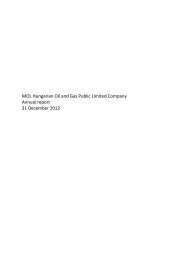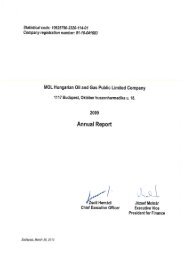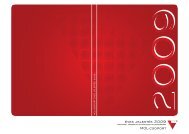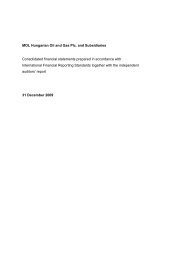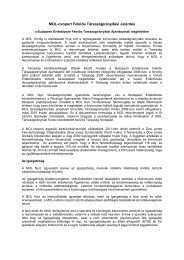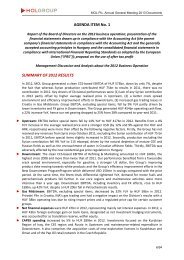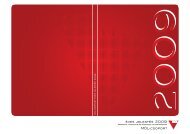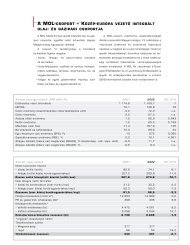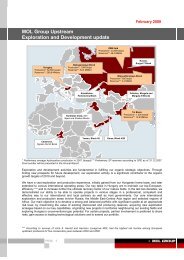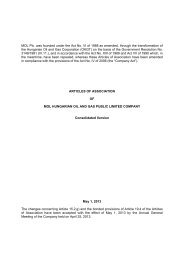MOL GROUP Annual Report
MOL GROUP Annual Report
MOL GROUP Annual Report
- No tags were found...
You also want an ePaper? Increase the reach of your titles
YUMPU automatically turns print PDFs into web optimized ePapers that Google loves.
vi) HedgingFor the purpose of hedge accounting, hedges are classified as– fair value hedges– cash flow hedges or– hedges of a net investment in a foreign operation.A hedge of the foreign currency risk of a firm commitment is accounted for as a cash flow hedge. At the inception of ahedge relationship, the Group formally designates and documents the hedge relationship to which the Group wishes to applyhedge accounting and the risk management objective and strategy for undertaking the hedge. The documentation includesidentification of the hedging instrument, the hedged item or transaction, the nature of the risk being hedged and how theentity will assess the hedging instrument’s effectiveness in offsetting the exposure to changes in the hedged item’s fair valueor cash flows attributable to the hedged risk. Such hedges are expected to be highly effective in achieving offsetting changesin fair value or cash flows and are assessed on an ongoing basis to determine that they actually have been highly effectivethroughout the financial reporting periods for which they were designated.Hedges which meet the strict criteria for hedge accounting are accounted for as follows:Fair value hedgesFair value hedges are hedges of the Group’s exposure to changes in the fair value of a recognized asset or liability or anunrecognized firm commitment, or an identified portion of such an asset, liability or firm commitment, that is attributableto a particular risk that could affect the income statement.For fair value hedges, the carrying amount of the hedged item is adjusted for gains and losses attributable to the risk beinghedged, the derivative is remeasured at fair value and gains and losses from both are taken to the income statement. For fairvalue hedges relating to items carried at amortised cost, the adjustment to carrying value is amortised through the incomestatement over the remaining term to maturity. Any adjustment to the carrying amount of a hedged financial instrument forwhich the effective interest method is used is amortised to the income statement.Amortisation may begin as soon as an adjustment exists and shall begin no later than when the hedged item ceases to beadjusted for changes in its fair value attributable to the risk being hedged.Hedges of a net investmentHedges of a net investment in a foreign operation, including a hedge of a monetary item that is accounted for as part ofthe net investment, are accounted for in a way similar to cash flow hedges. Gains or losses on the hedging instrumentrelating to the effective portion of the hedge are recognized as other comprehensive income while any gains or lossesrelating to the ineffective portion are recognized in the income statement. On disposal of the foreign operation, thecumulative value of any such gains or losses recognized as other comprehensive income is transferred to the incomestatement.vii) Impairment of Financial AssetsThe Group assesses at each balance sheet date whether a financial asset or group of financial assets is impaired. Impairmentlosses on a financial asset or group of financial assets are recognised only if there is an objective evidence of impairmentdue to a loss event and this loss event significantly impacts the estimated future cash flows of the financial asset or group offinancial assets.Assets carried at amortised costIf there is objective evidence that an impairment loss on loans and receivables carried at amortised cost has beenincurred, the amount of the loss is measured as the difference between the asset’s carrying amount and the presentvalue of estimated future cash flows (excluding future expected credit losses) discounted at the financial asset’soriginal effective interest rate (i.e. the effective interest rate computed at initial recognition). The amount of the lossis recognized in the income statement.The Group first assesses whether objective evidence of impairment exists individually for financial assets that are individuallysignificant, and individually or collectively for financial assets that are not individually significant. If it is determined that noobjective evidence of impairment exists for financial assets, whether significant or not, the asset is included in a group offinancial assets with similar credit risk characteristics and that group of financial assets is collectively assessed for impairment.Assets that are individually assessed for impairment and for which an impairment loss is or continues to be recognized arenot included in a collective assessment of impairment.If, in a subsequent period, the amount of the impairment loss decreases and the decrease can be related objectively to anevent occurring after the impairment was recognized, the previously recognized impairment loss is reversed. Any subsequentreversal of an impairment loss is recognized in the income statement, to the extent that the carrying value of the asset doesnot exceed its amortised cost at the reversal date.Notes to the financialstatementsWhen an unrecognized firm commitment is designated as a hedged item, the subsequent cumulative change in the fair value of thefirm commitment attributable to the hedged risk is recognized as an asset or liability with a corresponding gain or loss recognizedin the income statement. The changes in the fair value of the hedging instrument are also recognized in the income statement.The Group discontinues fair value hedge accounting if the hedging instrument expires or is sold, terminated or exercised, thehedge no longer meets the criteria for hedge accounting or the Group revokes the designation.Cash-flow hedgesCash flow hedges are a hedge of the exposure to variability in cash flows that is attributable to a particular risk associatedwith a recognized asset or liability or a highly probable forecast transaction that could affect the income statement. Theeffective portion of the gain or loss on the hedging instrument is recognized directly as other comprehensive income, whilethe ineffective portion is recognized in the income statement.Amounts taken to other comprehensive income are transferred to the income statement when the hedged transactionaffects the income statement, such as when hedged financial income or financial expense is recognized or when a forecastsale or purchase occurs. Where the hedged item is the cost of a non-financial asset or liability, the amounts previously takento equity are transferred to the initial carrying amount of the non-financial asset or liability.If the forecast transaction is no longer expected to occur, amounts previously recognized in equity are transferred to theincome statement. If the hedging instrument expires or is sold, terminated or exercised without replacement or rollover,or if its designation as a hedge is revoked, amounts previously recognized in other comprehensive income remain in othercomprehensive income until the forecast transaction occurs. If the related transaction is not expected to occur, the amountis taken to the income statement.Available-for-sale financial investmentsIf an available-for-sale asset is impaired, an amount comprising the difference between its cost (net of anyprincipal payment and amortisation) and its current fair value, less any impairment loss previously recognized inthe income statement, is transferred from other comprehensive income to the income statement. Impairmentlosses recognized on equity instruments classified as available for sale are not reversed; increases in their fair valueafter impairment are recognised directly in other comprehensive income. Impairment losses recognized on debtinstruments classified as available for sale are reversed through the income statement; if the increase in fair valueof the instrument can be objectively related to an event occurring after the impairment loss was recognized in theincome statement.viii) Cash and Cash EquivalentsCash includes cash on hand and cash at banks. Cash equivalents are short-term, highly liquid investments that are readilyconvertible to known amounts of cash with maturity less than three months from the date of acquisition and that are subjectto an insignificant risk of change in value.ix) Trade ReceivablesReceivables are stated at face value less provision for doubtful amounts. Where the time value of money is material,receivables are carried at amortized cost. A provision for impairment is made when there is objective evidence (such asthe probability of insolvency or significant financial difficulties of the debtor) that the Group will not be able to collect allof the amounts due under the original terms of the invoice. Impaired debts are derecognized when they are assessed asuncollectible.98 <strong>MOL</strong> Group annual report 2010 99



